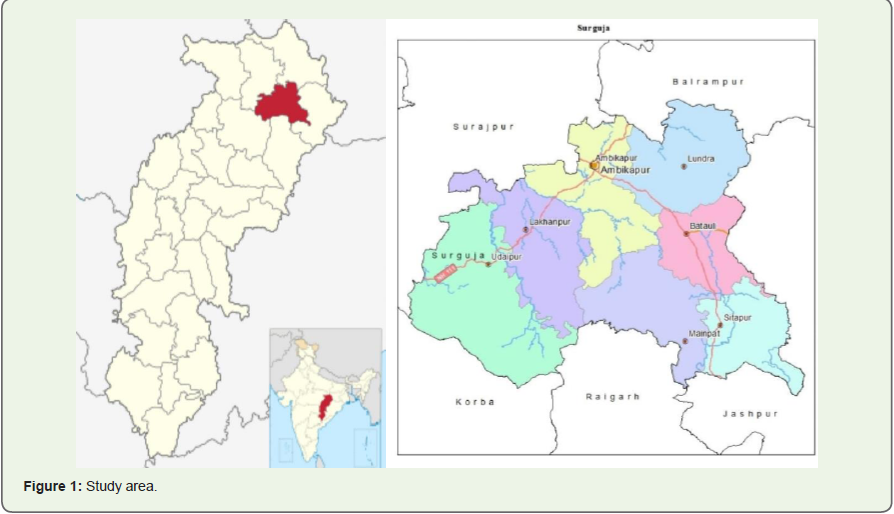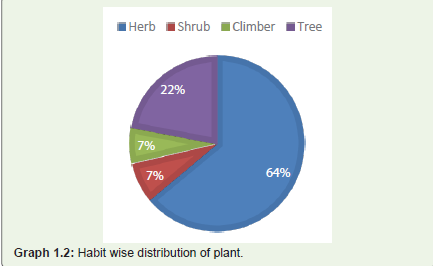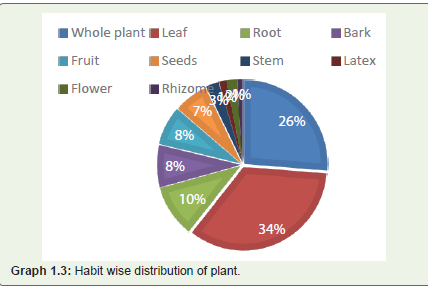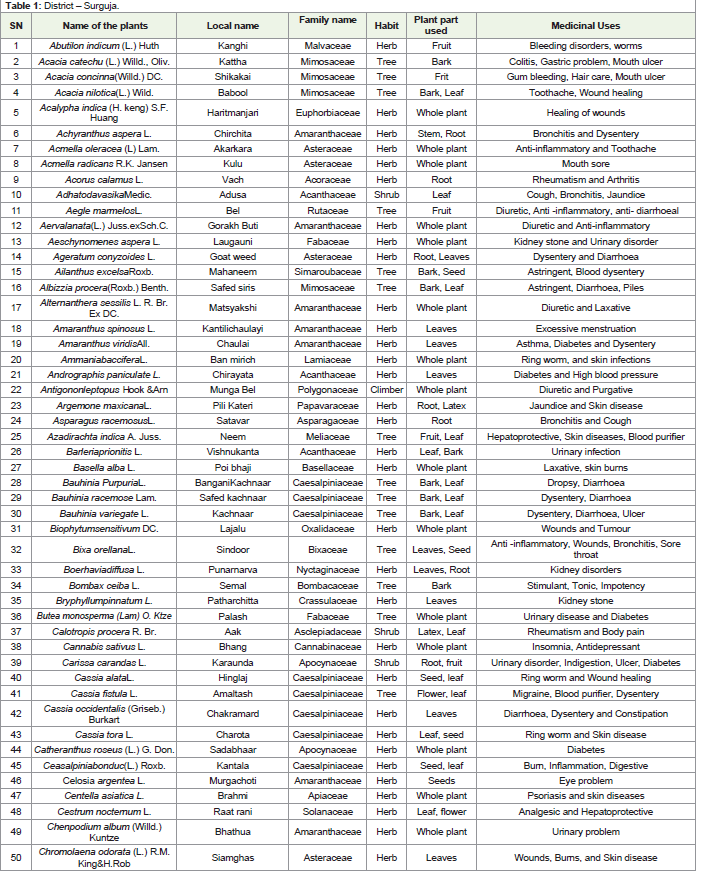Research Article
Studies of Traditional Medicinal Plants of Surguja District (C.G.)
Verma S1*, Dubey V2 and Sharma RP3
1 Department of Botany , Government Agrasen College, Bilha, Bilaspur, Chhattisgarh India
2 Head of the Department, C.M.Dubey P.G. College, Bilaspur, Chhattisgarh India
3 Government Agrasen College, Bilha, Bilaspur, Chhattisgarh India
2 Head of the Department, C.M.Dubey P.G. College, Bilaspur, Chhattisgarh India
3 Government Agrasen College, Bilha, Bilaspur, Chhattisgarh India
*Corresponding author: Shubha Verma, Department of Botany, Govt. Agrasen College, Bilha, Bilaspur, Chhattisgarh India E-mail Id: vermashubha27@gmail.com Mobile Number-9926134188
Copyright: © Verma S, et al. 2023. This is an open access article distributed under the Creative Commons Attribution License, which permits unrestricted use, distribution, and reproduction in any medium, provided the original work is properly cited.
Article Information: Submission: 05/05/2023; Accepted: 07/06/2023; Published: 12/06/2023
Abstract:
Surguja is a tribal dominated district in the north-eastern part of the Chhattisgarh State of India. Surguja district harbours rich biodiversity of medicinal plants. People of Surguja district, using indigenous local medicinal plants for the treatment of various diseases. During April 2022 to March 2023 field
surveys were conducted in Lundra, Ambikapur, Udaipur, Lakhanpur and Batauli block and a total 152 species of medicinal plants were recorded belonging to 52 families. In these 147 were dicot and 5 species were monocot. Fabaceae was the largest family with the 14 species, Asteraceae, Lamiaceae,
Caesalpiniaceae, Euphorbiaceae, Amaranthaceae and Solanaceae were the dominating families belonging to 8 to 10 species of medicinal plants. Twentyeight families were represented by single genera. Out of 152 species 95 were herbs, 12 species were shrub, 10 species were climber and the rest of the 33
species were trees. Plant parts used as a medicine were leaf, stem, bark, root, rhizome, latex, seeds, flower and 26% times whole plant. About 152 species, 34 percent of leaves, are being used as medicine. Ten percent times roots, 26 percent times whole plants are used as a medicine for treatment of different
diseases.Keywords: Medicinal plants; Surguja district; Medicine men; Herbal healers
Introduction
Surguja district houses a rich diversity of medicinal plants. 80%
of rural dwellers of Surguja district, relying on the indigenous plant
species for treatment of various diseases. A large number of plants
are known as the main source of drug therapy in various traditional
healthcare practices (Martini- Bettole 1980) [1]. The types of plants
and methods of application vary from locality to locality. A medicinal
plant is one whose organs contain some substances that can be used
for therapeutic use (Sofawara 1982) [2]. According to Adhikari, et al
(2010)[3] plants having active chemical compounds with any of its
parts like root, stem, leaves, bark, fruit and seeds, which produces
definite curing properties in the treatment of various diseases is
regarded as medicine. They are potential source of the number of new
compounds which can be used for drug development. Medicinal plants
are the main source of the traditional medicines. They are a potential
source of the number of new compounds which can be used for drug
development. The documentation of diversity and traditional uses of
medicinal flora can prove pivotal in the conservation and sustainable
use of plant resources. This baseline information on traditional uses
of medicinal plants can also provide information regarding designing
and development of future drugs.
Study Site
Surguja district is located in the northern part of Chhattisgarh.
Surguja district is spread over with high lands/uplands and dense
forest in its north and south region and it lies between 22 0 94’ to 24
0 6’ N latitude and 810 35’ to 84 0 5’ E longitude. The study sites are
five blocks of Surguja district such as Lundra, Ambikapur, Udaipur,
Lakhanpur and Batauli. These are located 30 to 35km away from each
other [Figure 1].
Climatic Condition:
The major type of soil is red and yellow, second important soil is
alluvial soil. In Surguja rainfall varies between 1000-2000 mm, with
mean annual temperature 260C to 270C and relative humidity is 60-
80%. Surguja district has tropical climate, which is favourable for
germination and growth of many of the plants which have medicinal
value. Moderate rainfall during the month of July and September also
supports luxurious growth of plants.Materials and Methods
The study includes extensive and thorough field surveys. Plant
explorations were carried out every alternate month. We have covered
all different seasons of the year at villages of five selected blocks. Plant
collections were done from August 2020 to May 2022. Fresh plant
specimens were collected and dried within a wooden press. Herbarium
sheets were prepared of these collected plant specimens according
to the method suggested by Jain &Rao (1976) [4].The specimens
were identified with the help of available literature (Kirtikar et al.
1984,Panigrahi et al. 1989, Jain S.K. 1991 and Pullaiah, T. 2006) [5-8].
Voucher specimens were deposited at Botany Department of CMD
PG College, Bilaspur. The specimens were identified with the help
of available literature. Medicinal importance of the plant species has
been described according to local herbalists and available literature.
Name of medicinal plants, family name, local name, habit, plant
parts used and their medicinal importance have been depicted in
[Table 1.1] . Habit wise distribution and plant parts used have been
shown in pie graph 1.2 and 1.3.
Result and Discussion
Medicinal knowledge given by local medicine men, more than
10 species were more effective for treatment of different diseases.
Local inhabitant villagers and tribes used those plants to cure their
health related problems. They prepare some pest and decoction from
these medicinal plants and utilize them to treat different ailments.
Frequently obtain herbaceous medicinal species are Abutilon
indicum, Ageratum conyzoides , Amaranthus viridis, Cassia
alata, Chenopodium album, Canscora diffusa, Elephantopusscaber,
Euphorbia thymifolia, Leucosporamultifida, Ocimumbasilicum,
Phyllanthus amarus. In this survey total 152 species of medicinal
plants belonging to 129 genera out of 52 families were recorded. Out
of 52 families, 47 were dicots and only 5 families were monocots.
Fabaceae was the largest family with 14 species, followed by
Asteraceae and Lamiaceae families, which is represented by 10
species each. Caesalpiniaceae and Euphorbiaceae have been recorded
by 9 medicinal species each. Eight medicinal species belonged to the
Amaranthaceae and Solanaceae family. Twenty-eight families were
represented by a single genus.
Out of 152 species 95 were herbs, 13 species were shrub, 10 species
were climbers and rest of the 34 species were of trees. Plant parts used
as a medicine were leaf, stem, bark, root, rhizome, latex, seeds and
flowers. Sometimes the whole plant containing the medicinal value is
used. The types of plants and methods of application vary from locality
to locality. Thirty four percent of leaves are used as medicine and 26%
times the whole plant is being used as a medicine. Root has been
used 10% times. The ratio of bark and fruit were 8% each. Seeds are
being used 7% times, Stem and flowers were covering 3 and 2 percent
respectively. Latex and rhizome both covered one percent. Similar
results obtained by some researchers such as Adhikari (2010), [3]
Martinez. (1995), [9] Pullaiah (2006) [8] and. Verma et al (1993) [10].
This medicinal knowledge is given by local medicine men / herbal
healers called Vaidya or Baigas in this region. Phytochemical studies
are required for confirmation of medicinal properties of plants.
Conclusion
Surveys of medicinal plants are very important for starting
material for pharmacological research and drug discovery. The
plants used in the rural healthcare system are of great interest which
may lead to drug discovery through Phytochemical profiling and
standardization of raw materials.
There is no proper report of the present status of these medicinal
plants in Surguja District. Purpose of this present study is to enumerate
the medicinal plants of Surguja district. The documentation of diversity
and uses of medicinal flora can prove pivotal in the conservation and
sustainable use of plant resources.




